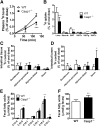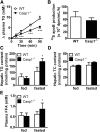Caspase-1 deficiency in mice reduces intestinal triglyceride absorption and hepatic triglyceride secretion
- PMID: 23160218
- PMCID: PMC3588871
- DOI: 10.1194/jlr.M031963
Caspase-1 deficiency in mice reduces intestinal triglyceride absorption and hepatic triglyceride secretion
Abstract
Caspase-1 is known to activate the proinflammatory cytokines IL-1β and IL-18. Additionally, it can cleave other substrates, including proteins involved in metabolism. Recently, we showed that caspase-1 deficiency in mice strongly reduces high-fat diet-induced weight gain, at least partly caused by an increased energy production. Increased feces secretion by caspase-1-deficient mice suggests that lipid malabsorption possibly further reduces adipose tissue mass. In this study we investigated whether caspase-1 plays a role in triglyceride-(TG)-rich lipoprotein metabolism using caspase-1-deficient and wild-type mice. Caspase-1 deficiency reduced the postprandial TG response to an oral lipid load, whereas TG-derived fatty acid (FA) uptake by peripheral tissues was not affected, demonstrated by unaltered kinetics of [(3)H]TG-labeled very low-density lipoprotein (VLDL)-like emulsion particles. An oral gavage of [(3)H]TG-containing olive oil revealed that caspase-1 deficiency reduced TG absorption and subsequent uptake of TG-derived FA in liver, muscle, and adipose tissue. Similarly, despite an elevated hepatic TG content, caspase-1 deficiency reduced hepatic VLDL-TG production. Intestinal and hepatic gene expression analysis revealed that caspase-1 deficiency did not affect FA oxidation or FA uptake but rather reduced intracellular FA transport, thereby limiting lipid availability for the assembly and secretion of TG-rich lipoproteins. The current study reveals a novel function for caspase-1, or caspase-1-cleaved substrates, in controlling intestinal TG absorption and hepatic TG secretion.
Figures




Similar articles
-
Tissue-specific postprandial clearance is the major determinant of PPARgamma-induced triglyceride lowering in the rat.Am J Physiol Regul Integr Comp Physiol. 2009 Jan;296(1):R57-66. doi: 10.1152/ajpregu.90552.2008. Epub 2008 Oct 29. Am J Physiol Regul Integr Comp Physiol. 2009. PMID: 18971352
-
ApoAV reduces plasma triglycerides by inhibiting very low density lipoprotein-triglyceride (VLDL-TG) production and stimulating lipoprotein lipase-mediated VLDL-TG hydrolysis.J Biol Chem. 2004 Jul 2;279(27):27941-7. doi: 10.1074/jbc.M403240200. Epub 2004 Apr 16. J Biol Chem. 2004. PMID: 15090553
-
CD36 deficiency in mice impairs lipoprotein lipase-mediated triglyceride clearance.J Lipid Res. 2005 Oct;46(10):2175-81. doi: 10.1194/jlr.M500112-JLR200. Epub 2005 Jul 16. J Lipid Res. 2005. PMID: 16024917
-
Intestinal absorption, blood transport and hepatic and muscle metabolism of fatty acids in preruminant and ruminant animals.Reprod Nutr Dev. 1999 Jan-Feb;39(1):27-48. doi: 10.1051/rnd:19990102. Reprod Nutr Dev. 1999. PMID: 10222498 Review.
-
Omega-3 fatty acids eicosapentaenoic acid and docosahexaenoic acid and their mechanisms of action on apolipoprotein B-containing lipoproteins in humans: a review.Lipids Health Dis. 2017 Aug 10;16(1):149. doi: 10.1186/s12944-017-0541-3. Lipids Health Dis. 2017. PMID: 28797250 Free PMC article. Review.
Cited by
-
Analyses of caspase-1-regulated transcriptomes in various tissues lead to identification of novel IL-1β-, IL-18- and sirtuin-1-independent pathways.J Hematol Oncol. 2017 Feb 2;10(1):40. doi: 10.1186/s13045-017-0406-2. J Hematol Oncol. 2017. PMID: 28153032 Free PMC article.
-
Apolipoprotein CIII overexpression exacerbates diet-induced obesity due to adipose tissue higher exogenous lipid uptake and retention and lower lipolysis rates.Nutr Metab (Lond). 2015 Dec 23;12:61. doi: 10.1186/s12986-015-0058-6. eCollection 2015. Nutr Metab (Lond). 2015. PMID: 26705406 Free PMC article.
-
Inflammasome Complexes: Emerging Mechanisms and Effector Functions.Cell. 2016 May 5;165(4):792-800. doi: 10.1016/j.cell.2016.03.046. Cell. 2016. PMID: 27153493 Free PMC article. Review.
-
Intestine-Specific Mttp Deletion Increases the Severity of Experimental Colitis and Leads to Greater Tumor Burden in a Model of Colitis Associated Cancer.PLoS One. 2013 Jun 21;8(6):e67819. doi: 10.1371/journal.pone.0067819. Print 2013. PLoS One. 2013. PMID: 23805328 Free PMC article.
-
Tissue-Specific Ablation of Liver Fatty Acid-Binding Protein Induces a Metabolically Healthy Obese Phenotype in Female Mice.Nutrients. 2025 Feb 21;17(5):753. doi: 10.3390/nu17050753. Nutrients. 2025. PMID: 40077623 Free PMC article.
References
-
- Trayhurn P., Wood I. S. 2005. Signalling role of adipose tissue: adipokines and inflammation in obesity. Biochem. Soc. Trans. 33: 1078–1081 - PubMed
-
- He F., Doucet J. A., Stephens J. M. 2008. Caspase-mediated degradation of PPARgamma proteins in adipocytes. Obesity (Silver Spring). 16: 1735–1741 - PubMed
Publication types
MeSH terms
Substances
LinkOut - more resources
Full Text Sources
Other Literature Sources
Molecular Biology Databases
Miscellaneous

